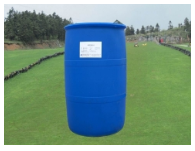The surface tension and surface energy can be reduced by adding surfactant to the precursor of nano materials, so as to reduce the aggregation degree of solid or liquid particles in the dispersion system, keep the dispersion system relatively stable, and effectively regulate the size and morphology of nanoparticles.
The addition of surfactant can play a steric hindrance on the surface of ZnO precursor, reduce the direct contact between particles and avoid agglomeration due to hydrogen bond or van der Waals force. In the precursor formation stage, the surfactant adsorbs on the surface of the precursor powder, which makes it difficult for the particles to agglomerate. During vacuum drying, the surfactant molecules form monolayers on the surface of the particles, which reduces the contact surface between solvent and air, and the surface tension drops sharply. The particles are not easy to get close to each other, which reduces the agglomeration degree of micro powder. In addition, the electrostatic effect of surfactants can also reduce the agglomeration degree of micro powder to a certain extent.

Zinc sulfate and ammonium bicarbonate were used as raw materials, and polyethylene glycol (PEG) was added before the reaction to obtain basic zinc carbonate precursor without agglomeration; or nano zinc oxide with smaller particle size and better dispersion could be prepared by adding surfactant peg in the solid-state reaction process; if the composite non-ionic surfactant which can form liquid crystal was used as molecular template, ultrasonic wave was used to form liquid crystal Under the control of sol method, parallel bundle like ZnO whiskers with an equivalent average diameter of 50 nm can be prepared.
Using Zn (NO3) 2 · 6H2O and Na2CO3-NaHCO3 as raw materials, anionic surfactant as emulsifier and organic solvent as dispersant, the precursor was prepared by emulsion method. The nano ZnO obtained by thermal decomposition was standard hexagonal system with an average particle size of 13.5nm. If PVP was used as surface modifier, the precursor was prepared by emulsification, ZnO nanoparticles with narrow particle size distribution and average particle size of 4.0 nm can be synthesized.
Peg with different molecular weight is used as macromolecular surfactant to form supramolecular template in a specific micelle concentration range and medium system, i.e. "micro reactor". Nano ZnO materials with spherical and needle rod shape and hexagonal, flake and spiral rod shape with uniform dispersion can be prepared. Polyethylene glycol-400 is used as the surface The size of nano ZnO powder synthesized by sol-gel method can reach about 70nm, and the particle size is uniform. The particle size distribution range is narrow. A certain amount of nano ZnO powder is selected. The content of ZnO is analyzed by titrimetric analysis. It is found that the purity of the powder can reach more than 99%.
Nano ZnO with certain morphology can be prepared by adding surfactant to a certain extent. Zn (CH3COO) 2 · 2H2O and (COOH) 2 · 2H2O were used as raw materials and ethylenediamine as surfactant. Without ethylenediamine, most of the ZnO nanoparticles are spherical or nearly spherical, with small size and uniform distribution. The average diameter is about 30nm, and there are no needle like, rod-shaped and short column like ZnO particles; if ethylenediamine is added in the same reaction system, the rod-shaped nano ZnO particles are obtained. Wu Qingsheng and others also found a similar phenomenon in the preparation of PbCl2 nanowires.